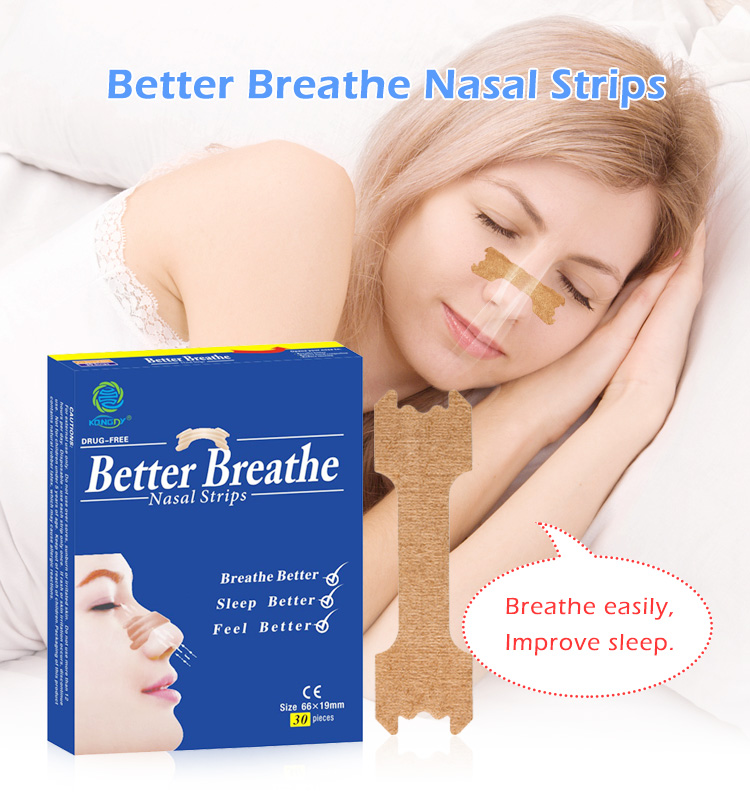Author:Kangdi 03-06-2024
Nasal congestion is a common ailment that can significantly impact our daily lives, causing discomfort, difficulty breathing, and even disrupting sleep. While many people turn to over-the-counter decongestants for relief, these medications can have potential side effects and may not be suitable for everyone. Fortunately, nasal strips have emerged as a safe and natural alternative, offering a drug-free solution for clearing nasal congestion and promoting easier breathing.
01. The Drawbacks of Decongestants
Decongestants are medications designed to constrict blood vessels in the nasal passages, reducing swelling and relieving congestion. However, while they can provide temporary relief, they come with potential risks and side effects. Some common concerns associated with decongestant use include:
1. Rebound Congestion: Long-term use of decongestants can lead to a rebound effect, causing nasal passages to become even more congested after the medication wears off.
2. Increased Blood Pressure: Certain decongestants can raise blood pressure, which can be problematic for individuals with hypertension or heart conditions.
3. Insomnia and Restlessness: Many decongestants contain stimulants that can interfere with sleep and cause restlessness.
4. Interactions with Other Medications: Decongestants can interact with various prescription drugs, potentially causing adverse reactions or reducing their effectiveness.
2. The Benefits of Nasal Strips
Nasal strips offer a safe and natural alternative to decongestants, providing relief without the potential side effects associated with medications. These adhesive bandages, worn across the bridge of the nose, gently lift and open the nasal passages, facilitating easier breathing. Here are some of the key benefits of using nasal strips:
1. Drug-Free Relief: Unlike decongestants, nasal strips do not contain any medication, making them a safer option for individuals who prefer to avoid drugs or are concerned about potential interactions.
2. Improved Sleep Quality: By promoting easier breathing, nasal strips can help reduce snoring and improve sleep quality, leading to better rest and recovery.
3. Enhanced Athletic Performance: For athletes and active individuals, nasal strips can improve airflow and oxygen intake, potentially boosting endurance and performance.
4. Suitable for All Ages: Nasal strips are generally considered safe for use by people of all ages, including children and the elderly, who may be more susceptible to the side effects of decongestants.
03. Using Nasal Strips Effectively
To maximize the benefits of nasal strips, it's important to use them correctly. Start by cleaning the area around your nose and ensure the skin is dry. Then, carefully apply the strip across the bridge of your nose, following the manufacturer's instructions for proper placement and adhesion.
For best results, it's recommended to use nasal strips at night or during periods of rest, allowing the nasal passages to open and stay open throughout the night. Some individuals may also find it helpful to use nasal strips during physical activity or when engaging in outdoor activities that could exacerbate nasal congestion.
It's important to note that while nasal strips are generally safe for most individuals, those with certain medical conditions or allergies should consult with a healthcare professional before use.
In a world where we are increasingly seeking natural and drug-free alternatives, nasal strips offer a convenient and effective solution for relieving nasal congestion. By promoting easier breathing and improved airflow, these simple devices can enhance sleep quality, support athletic performance, and provide relief from the discomfort of nasal congestion without the potential side effects of decongestants. Whether you're an athlete, a busy professional, or someone who values a natural approach to wellness, nasal strips are worth considering as a safe and natural alternative to traditional decongestants.
 0086 19937104978
0086 19937104978





